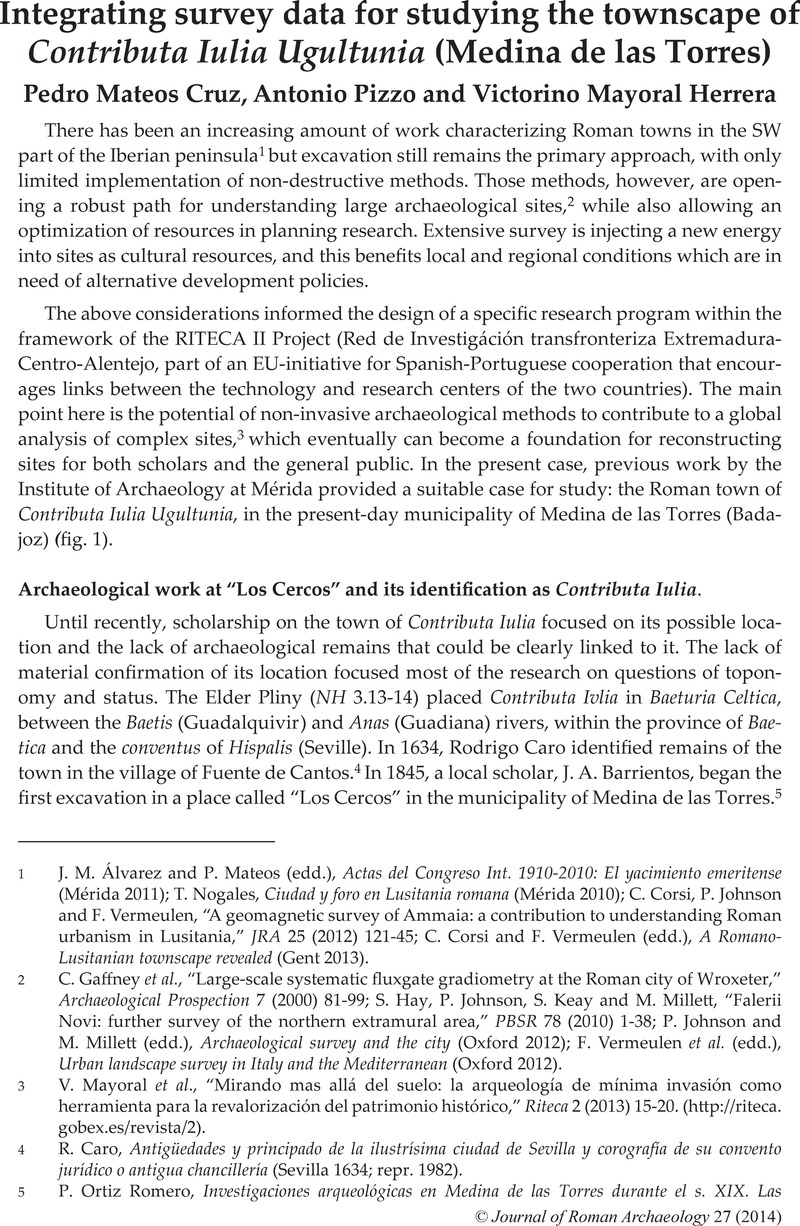Published online by Cambridge University Press: 27 November 2014

1 Álvarez, J. M. and Mateos, P. (edd.), Actas del Congreso Int. 1910-2010: El yacimiento emeritense (Mérida 2011)Google Scholar; Nogales, T., Ciudad y foro en Lusitania romana (Mérida 2010)Google Scholar; Corsi, C., Johnson, P. and Vermeiden, F., “A geomagnetic survey of Ammaia: a contribution to understanding Roman urbanism in Lusitania,” JRA 25 (2012) 121–45Google Scholar; Corsi, C. and Vermeulen, F. (edd.), A Romano-Lusitanian townscape revealed (Gent 2013)Google Scholar.
2 Gaffney, C. et al., “Large-scale systematic fluxgate gradiometry at the Roman city of Wroxeter,” Archaeological Prospection 7 (2000) 81–99 3.0.CO;2-6>CrossRefGoogle Scholar; Hay, S., Johnson, P., Keay, S. and Millett, M., “Falerii Novi: further survey of the northern extramural area,” PBSR 78 (2010) 1–38 Google Scholar; Johnson, P. and Millett, M. (edd.), Archaeological survey and the city (Oxford 2012)CrossRefGoogle Scholar; Vermeulen, F. et al. (edd.), Urban landscape survey in Italy and the Mediterranean (Oxford 2012)CrossRefGoogle Scholar.
3 Mayoral, V. et al., “Mirando mas allá del suelo: la arqueología de mínima invasión como herramienta para la revalorización del patrimonio histórico,” Riteca 2 (2013) 15–20. (http://riteca.gobex.es/revista/2)Google Scholar.
4 Caro, R., Antigüedades y principado de la ilustrísima ciudad de Sevilla y corografía de su convento jurídico o antigua chancillería (Sevilla 1634; repr. 1982)Google Scholar.
5 Romero, P. Ortiz, Investigaciones arqueológicas en Medina de las Torres durante el s. XIX. Las excavaciones de los cerros y un manuscrito inédito de José Antonio Barrientos (Badajoz 2002)Google Scholar.
6 Gimeno, H. and Ramírez, J. L., “Nuevos testimonios arqueológicos y epigráficos de Medina de las Torres (Badajoz) en un manuscrito inédito del s. XIX,” Spal. Revista de prehistoria y arqueologia de la Universidad de Sevilla 7 (1998) 149–62CrossRefGoogle Scholar.
7 Mateos, P., Pizzo, A. and Delgado, P., “¿Contributa Iulia Ugultunia? Intervenciones arqueológicas en el yacimiento arqueológico de “Los Cercos”, en Medina de las Torres (Badajoz),” ROMVLA 8 (2009) 7–32 Google Scholar.
8 Mateos, P. and Pizzo, A., “Primeros datos acerca de la topografía y el urbanismo de Contributa Iulia (Medina de las Torres, Badajoz),” in Actas del VI Encuentro de Arqueología del Suroeste Peninsular (2014) 1425–58Google Scholar.
9 P. Ortiz et al., “Analizando el paisaje urbano de Contributa Iulia (Los Cercos, Medina de las Torres, Badajoz), a partir de fotografía aérea de baja altitud,” in Actas del VI Encuentro (supra n.8) 2429-52.
10 For a paradeigmatic case-study see J. J. Bintliff, “Contemporary issues in surveying complex urban sites in the Mediterranean region: the example of the city of Thespiai (Boeotia, central Greece),” in Vermeulen et al. (supra n.2) 44-52.
11 Manufactured by Veris Technologies Inc. of Salina, KS.
12 Maxor-GGDT from Javad Navigation Systems of San Jose, CA.
13 Moral, F. J., Terrón, J. M. and Silva, J. R. Marques Da, “Delineation of management zones using mobile measurements of soil apparent electrical conductivity and multivariate geostatistical techniques,” Soil & Tillage Research 106 (2010) 335–43CrossRefGoogle Scholar.
14 Simpson, D., “Evaluating the multiple coil configurations of the EM38DD and DUALEM-21S sensors to detect archaeological anomalies,” Archaeological Prospection 16 (2009) 91–102 CrossRefGoogle Scholar; Saey, T. et al., “Integrating multi-receiver electromagnetic induction measurements into the interpretation of the soil landscape around the School of Gladiators at Carnuntum,” Europ. J. Soil Science 64 (2013) 716–27CrossRefGoogle Scholar.
15 Abascal, J. M., Cebrian, R. and Trunk, M., “Epigrafía, arquitectura y decoración arquitectónica del foro de Segóbriga,” in Ramallo, S. (ed.), La decoración arquitectónica en las ciudades romanas de Occidente (Murcia 2004) 219–56Google Scholar.
16 Olcina, M. (ed.), Lucentum, arqueología e historia (Alicante 2009)Google Scholar
17 Schattner, T. G., Munigua: cuarenta años de investigaciones (Sevilla 2003) 46 Google Scholar.
18 Mateos, P. and Pizzo, A., “Un relieve funerario hallado en Contributa Iulia Ugultunia,” Spal 23 (2013) 167-78Google Scholar.
19 Gimeno and Ramirez (supra n.6) 151.
20 CIL II 984; Canto, A. Ma, Epigrafía romana de la Beturia Céltica (Madrid 1997) 110 Google Scholar.